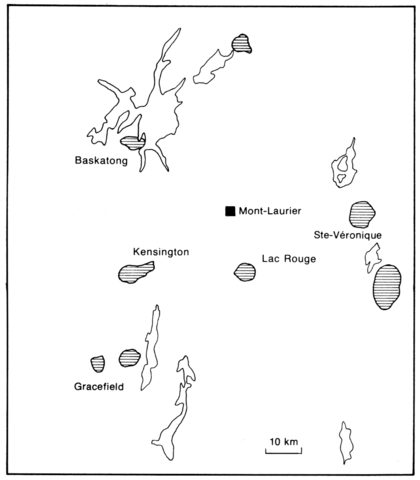stripes
An approximately circular intrusion 8 km in diameter, Ste-Veronique intrudes migmatites, schists and gneisses of the Grenville Province. The complex consists of an ultramafic core of diopsidic pyroxenites of which olivine, magnetite, hornblende and phlogopite-bearing varieties occur as well as types with up to 25% orthopyroxene. There is an outward transition from pyroxenites into shonkinites which contain up to 50% augite, K-feldspar, albite, 35% biotite, sometimes hornblende and accessories. These rocks are surrounded by syenites which vary from mesocratic varieties with up to 24% clinopyroxene and 12% biotite to leucocratic varieties of 70-85% K-feldspar plus albite and a little aegirine-augite, biotite and hastingsite. Towards the margin of the complex are discontinuous areas of nepheline syenite with as much as 21% nepheline and pulaskites with 1-6% nepheline. Both rock types contain K-feldspar and albite, a little aegirine- augite, amphibole and biotite. Fenites occur at the margin of the complex and as enclaves and involve the development of alkali feldspar, aegirine-augite, biotite and blue alkali amphibole.
RIVE, M. 1976. Region de Sainte-Veronique. Geological Report, Quebec Ministry of Natural Resources Geological Exploration Service, 182: 1-68.
TABET ABDUL-MALAK, V. 1978. Le complexe alcalin de Sainte-Veronique (Quebec, Canada): petrologie et geochimie. These, L'Universitee Claude Bernard, Lyon. 204pp.


